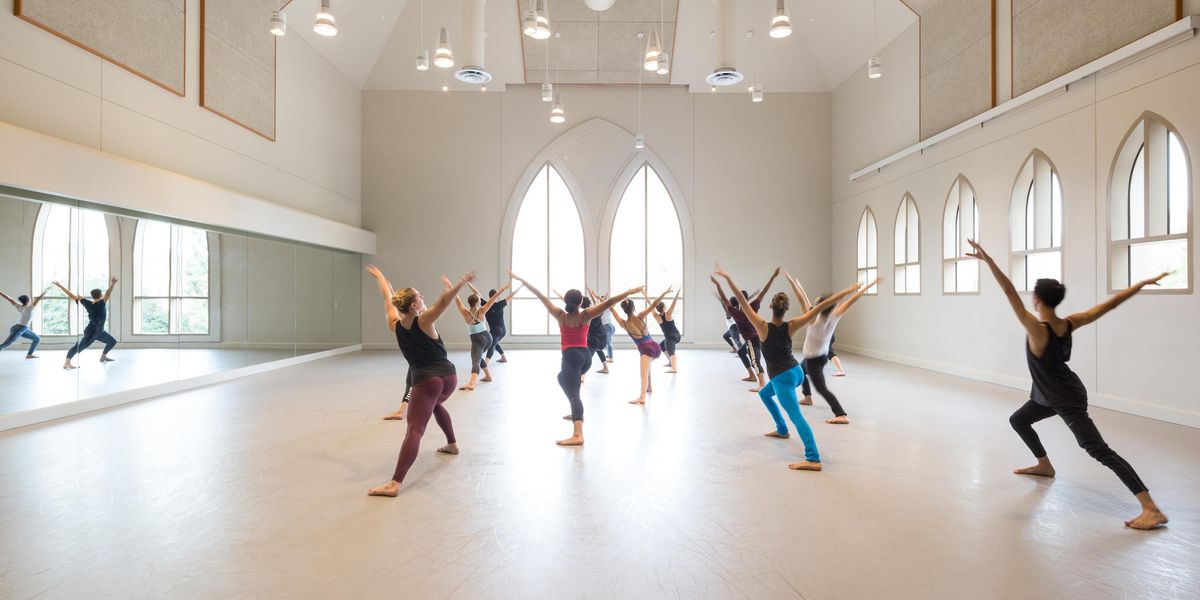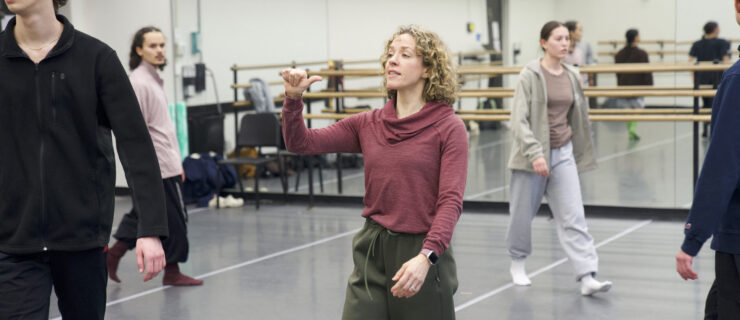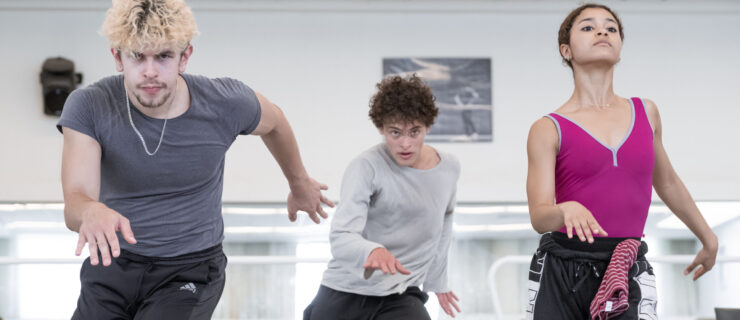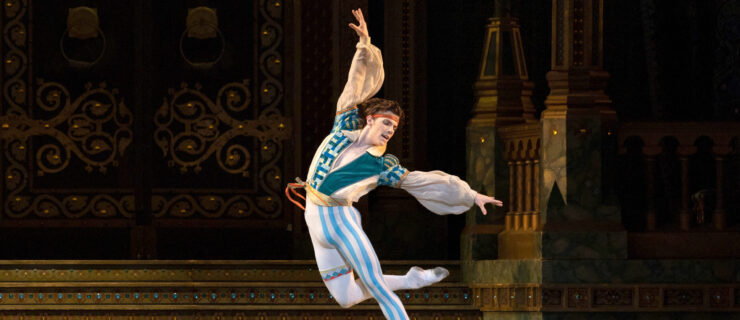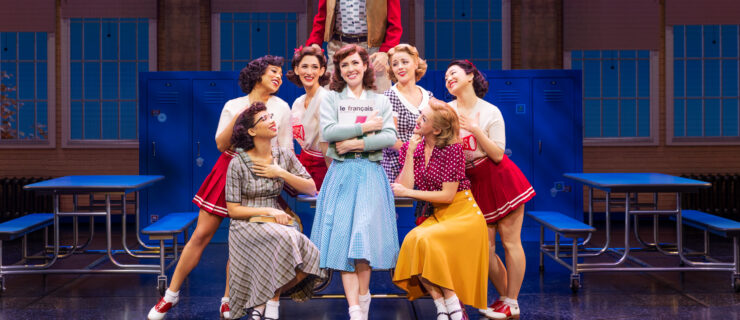Faith, Hope, Charity, & Dance
Choreographer Jane Weiner melds dance and activism at her Houston center.
With her back to the audience, Jane Weiner bourrées across the stage in a part-homage, part-pun on Giselle’s second act. She re-enters with a grandiose string of technical feats ending in a tragic splat on the floor. Weiner nails the essence of the “it’s so funny it’s tragic” spirit.
The audience howls, half-believing this poor girl has missed her mark. Her stage persona conjures a mix of postmodern movement sensibility with Carol Burnett’s deadpan wit and Buster Keaton’s physical humor.
In Night Moves, the solo Mark Dendy created for her, Weiner sheds her comedic demeanor to explore the territory of moving forward in life when you just can’t go on. Midway, Weiner curls up in fetal position and begins to weep silently. The intermittent vibrations of her shoulders fill the space with a restrained pathos.
Weiner knows firsthand about moving forward amidst a dire situation. After shepherding her sister through metastasized breast cancer and a harrowing bone marrow transplant, she found a new sense of purpose. While her dancing wins artistic accolades, her activism has raised over $1 million for breast cancer research, mammograms for uninsured women, and breast health education.
Weiner got a late start in dance, getting serious during her college years at Bowling Green State University in Ohio. She played catch-up in New York as a founding member of the Doug Elkins Dance Company in 1989. The late-in-life start keeps Weiner’s innocence as a mover intact, while a fierce bout of training makes her one of Houston’s most watchable dancers.
Houston became a frequent pit stop when her only sister, Susan Rafte, was diagnosed with breast cancer. She relocated there from New York when she got the news that her sister’s cancer had metastasized.
Weiner organized the first Pink Ribbons Project, dancers in motion against breast cancer, in New York City in 1995, along with choreographers Robin Staff, David Parker, and Sara Hook. The funds they raised went to help fast-track Taxotere, the medication that put Rafte’s cancer into remission. “I was literally dancing to save my sister’s life,” remembers Weiner. Eventually she moved Pink Ribbons to Houston and started Hope Stone Dance Company for herself and a small group of eager recruits. She has a knack for generating fun whether it be a dance concert or a fund-raiser. At Hope Stone’s first concert Weiner served pizza to the entire audience.
Once Rafte landed back on her feet, Weiner began to make more dances. Influenced by 10 years with the Elkins company, which pioneered an edgy, virtuostic blend of street vernacular with postmodern dance, she also looked to the example of Dendy, Donna Uchizono, and Jennifer Monson. “Monson opened up my thinking in letting go of counts. Doug taught me to trust my dancers. I picked them, and at some point it’s just not my material anymore,” says Weiner.
She gathers the best freelance dancers in town, and they enjoy her collaborative style of working. “I bring some movement ideas, but my dancers play until it works for all of us.” She cultivates a professional, but non-competitive, atmosphere. “We appreciate each other’s talent rather than be threatened by it,” says Erica Sandberg, the newest member of the company. As the only choreographer in the local community with a stint in a New York company under her belt, Weiner holds some local celebrity status. “When Jane asked me to dance with her I felt like I was asked to the prom,” joked Penny Tschirhart, a longtime Hope Stone dancer.
Weiner’s first evening-length work, The Cooking Show, premiered to full audiences and rave reviews in 2002. Her rowdy romp exposes Americans’ obsession with what goes in their mouths. Dancers stroke their throats in preparation for the neatly choreographed donut-munching session. An opera singer bellows out the instructions from the back of a peanut butter cracker wrapper as a Gregorian-type chant. In keeping with Weiner’s keen sense of the ridiculous, the performers served sorbet and tic tacs between sections.
Last November, Weiner reworked the show for the Wortham Center, a much larger venue. She tightened the ensemble work, punched up the comedy, and trimmed down extraneous material. Weiner never misses a beat for a cause—in this case, hurricane relief. She asked audience members to bring cans of non-perishables to create “a tower of food” sculpture for Houston Food Bank. In an impassioned post-show speech Weiner thanked the 400 children who came for taking a chance on modern dance.
Weiner has earned a string of positive reviews, the title “Best Modern Dance Company” of 2003 from The Houston Press, and a devoted following. Her fund-raising activities cross over into Hope Stone with ease. “Some fans come regardless of whether it’s Pink Ribbons or Hope Stone,” she says.
In 2003, Weiner organized all her activities under one roof. Hope Center houses the company, Pink Ribbons’ offices, and a dance school. As one of Houston’s few studios for professional modern dancers, Hope Center offers classes from ballet to Pilates, for all ages from children to adults. Weiner also teaches modern for the Houston Ballet’s summer program.
Breast cancer is not Weiner’s only cause. She also co-produces, with Dominic Walsh (see “25 to Watch” January 2004) and The Hobby Center for the Performing Arts, The Illumination Project, a yearly benefit for AIDS/HIV. “With recent events, people are forgetting about AIDS,” says Weiner. She also runs Kid’s Play, an arts program for at-risk children, and spent 10 summers teaching at-risk children through the Youth Arts Program at the Bates Dance Festival. This summer she will return for YAP’s 25th anniversary.
Her newest project, The Pink Aware Dancers, merges several of Weiner’s interests. When they travel to schools and community centers, their performances are followed by a breast education segment, delivered by a registered nurse.
So when does Weiner have time to choreograph? With this level of community involvement, she doesn’t expect to crank out a full-length work every year. Hope Stone rehearses twice a week and begins work on a new piece many months in advance. “I like to take my time, work for a few months, and then take a break,” says Weiner. “I have the company perform in small, fun, venues before the piece gels.”
Weiner tries to keep a foot in the New York scene. In addition to Dendy, Elkins created solos for her, and she collaborated on a duet with dance-theater artist David Neumann. A New York season graces her wish list. Her sister, who just celebrated her 11th year of being cancer-free, has assumed some of the responsibilities of the Pink Ribbons Project, leaving Weiner more time to develop the company.
Weiner dwells in the place where altruism and art come together. Her extraordinary efforts, both in the community and onstage, have made their mark in Houston. “Weiner has not stopped shaking things up in Houston since she arrived,” says Emily Todd of the Houston Endowment. “Her conscience keeps her busy as a social activist as well. She infuses her work with humor, humanity, and energy.” This past fall the Lance Armstrong Foundation came through with funds for a multidisciplinary program for breast cancer survivors. In 2005, Weiner received an award from the Society of Medical Oncology, and she was honored for her work as an artist and humanitarian by the C. G. Jung Center of Houston. During her acceptance speech she talked about how overwhelming a disease like cancer can be, and how hard it is to think we can really make a difference. She told the story of Kathy Garfunkle, who wove potholders that Pink Ribbons sells for $4. “When we sell enough of these, we have a mammogram for one uninsured woman,” said Weiner. Then, with an impish grin, she handed out potholders to the entire audience. It’s just like Weiner to leave this well-clad crowd with hope in the shape of a potholder. See www.pinkribbons.org or www.hopestoneinc.org.
Nancy Wozny, a teacher of the Feldenkrais Method, lives and writes in Houston.
